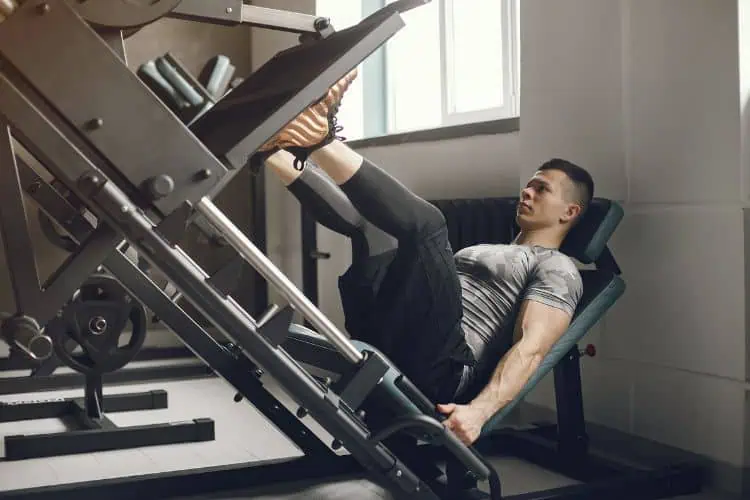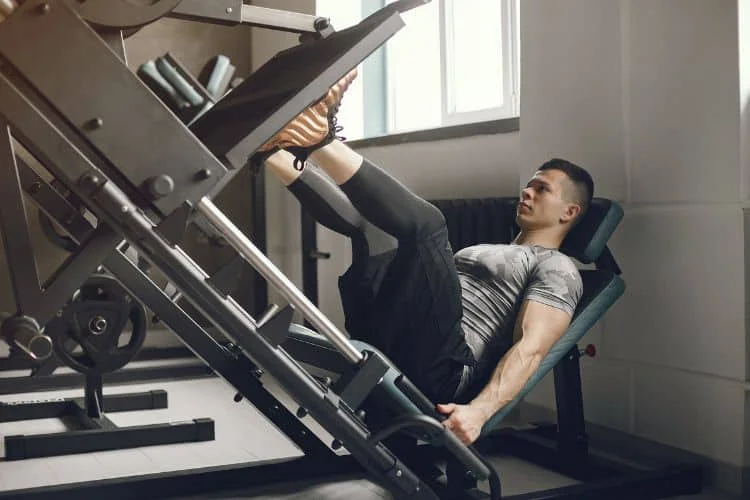
The leg press is a staple in leg day routines for building lower body strength and muscle mass. It allows you to target major leg muscles without the need for complex equipment setups or spotters, as is often the case with squats. Whether you’re looking to add mass to your quads, strengthen your hamstrings, or sculpt your glutes, incorporating a well-structured leg press workout can make a world of difference. This article breaks down everything you need to know about optimizing your leg press workout, including technique tips, the best leg press variations, and sample workouts to help you achieve your goals.
Why The Leg Press Workout Is Effective
The leg press machine primarily targets the quadriceps, hamstrings, and glutes, engaging these large muscle groups and allowing for impressive strength gains. One of the main advantages of the leg press is that it minimizes stress on the lower back and upper body, which can be especially beneficial for those recovering from injury or anyone looking to isolate the legs more directly. Here’s why the leg press deserves a place in your leg day routine:
- Muscle Isolation: The leg press allows for focused engagement of the lower body, reducing the need for core stabilization, which is often necessary in compound lifts.
- Controlled Movement: It offers a stable platform, allowing you to lift heavier weights safely and with proper form.
- Versatile Training Options: With different leg placements and angles, you can adjust the leg press to target specific muscles within the lower body.
Understanding Leg Press Mechanics and Proper Form
To maximize the effectiveness of the leg press, understanding proper form and technique is crucial. Here’s a step-by-step breakdown:
- Set Up the Machine: Adjust the seat so that your knees are at a 90-degree angle when your feet are on the platform. This position prevents overstretching the knees and ensures a safe range of motion.
- Foot Placement: Place your feet hip-width apart on the platform. Depending on the muscle emphasis, you can adjust the placement (high for glutes and hamstrings, low for quads).
- Movement Execution: Push the platform up by extending your legs, but avoid locking out your knees. Slowly lower the weight back down until your knees are at a 90-degree angle.
Common Leg Press Mistakes to Avoid
- Avoiding Full Range of Motion: Perform each rep with a full range of motion, bringing the knees to a 90-degree angle. Partial reps reduce the effectiveness of the exercise.
- Locking Out the Knees: Locking out your knees at the top of each rep places unnecessary stress on the knee joints.
- Using Excessive Weight: Focus on form over weight. Heavy weights with poor form increase injury risk and can impede long-term progress.
Variations of the Leg Press Workout
Adding variety to your leg press routine can help you target specific muscles and keep your workouts fresh and challenging. Here are the best leg press variations to consider:
1. Standard Leg Press
This is the classic version, focusing on balanced lower-body muscle activation.
- How to Perform: Keep feet hip-width apart, pushing evenly through both feet.
- Muscle Targeted: Primarily quads, with some glute and hamstring involvement.
2. Narrow Stance Leg Press
A narrow stance shifts more load onto the quads, making it ideal for building thigh muscle definition.
- How to Perform: Place your feet closer together on the platform, about 4-6 inches apart.
- Muscle Targeted: Primarily quads.
3. Wide Stance Leg Press
The wide stance variation emphasizes the inner thigh muscles and glutes.
- How to Perform: Position your feet wider than shoulder-width apart, angling toes slightly outward.
- Muscle Targeted: Inner thighs, glutes, and hamstrings.
Placing your feet higher on the platform engages more glutes and hamstrings, making it ideal for developing a fuller lower body.
- How to Perform: Position your feet toward the top of the platform.
- Muscle Targeted: Glutes and hamstrings.
This variation increases the emphasis on the quadriceps.
- How to Perform: Place your feet low on the platform, about 4-6 inches apart.
- Muscle Targeted: Quads.
6. Single-Leg Press
The single-leg press helps correct muscle imbalances and ensures each leg is equally developed.
- How to Perform: Place one foot on the platform and the other leg off to the side. Complete a full set before switching legs.
- Muscle Targeted: Quads, glutes, hamstrings (depending on foot placement).
Leg Press Workout Routine
Below is a leg press workout routine designed to target different muscle groups and build both strength and muscle mass. This workout can be performed once a week as part of a comprehensive leg day.
Leg Press Workout Routine Example
- Standard Leg Press: 4 sets of 10 reps
- Use moderate to heavy weight with a focus on a full range of motion.
- Wide Stance Leg Press: 3 sets of 12 reps
- Place feet wider than shoulder-width, engaging inner thighs and glutes.
- Narrow Stance Leg Press: 3 sets of 15 reps
- Focus on quads with a closer foot stance.
- High Foot Placement Leg Press: 3 sets of 12 reps
- Engage more glute and hamstring muscles by placing feet higher on the platform.
- Single-Leg Press: 3 sets of 12 reps per leg
- This is excellent for targeting imbalances and enhancing overall leg symmetry.
Tips for Effective Leg Press Workouts
- Warm Up First: Start with a 5-10 minute cardio warm-up followed by dynamic stretching for the lower body. This helps prepare the muscles and prevent injury.
- Focus on Tempo: Control the lowering phase, taking about 3 seconds to descend and 1 second to press up. A slower tempo increases time under tension, boosting muscle growth.
- Adjust Weight Accordingly: Progressively overload by adding weight as you gain strength, but avoid sacrificing form for heavier loads.
- Consider a Split Routine: To maximize growth, consider pairing your leg press workout with exercises that target calves and other supporting muscles, creating a well-rounded lower body workout day.
Leg Press vs. Squat: Which is Better?
The leg press and the squat are both excellent exercises for building leg strength, but each has distinct advantages.
Benefits of the Leg Press
- Less Strain on the Back: Unlike squats, the leg press places minimal stress on the lower back, which is ideal for individuals with back pain or limitations.
- Isolation of Leg Muscles: The leg press isolates the lower body better, allowing for focused engagement of the legs.
Benefits of the Squat
- Core Activation: Squats engage the core muscles, promoting functional strength.
- Full-Body Activation: Squats involve more muscles than the leg press, making them ideal for total-body conditioning.
Which is Right for You?
Both exercises are effective, and ideally, you can incorporate both into your routine. However, if you’re recovering from an injury or looking to isolate the legs, the leg press may be a better option. For functional strength and athletic performance, squats provide additional benefits.
Frequently Asked Questions About the Leg Press
How Often Should I Do the Leg Press Workout?
For most people, doing the leg press once a week is enough. However, if your focus is on building leg strength and muscle, you may benefit from including it twice a week. Be sure to allow adequate recovery between workouts.
A high and wide foot placement on the platform is the best for targeting the glutes, as it shifts more load toward the back of the leg.
Can I Do the Leg Press Instead of Squats?
While the leg press is an effective alternative to squats, it’s not a complete replacement. Squats engage more muscles, especially the core, and provide functional strength benefits. Including both exercises in your routine offers a balanced approach.
Is the Leg Press Safe for Beginners?
Yes, the leg press is beginner-friendly. Just ensure you start with light weight, focus on form, and avoid locking your knees. Beginners should also work with a coach or trainer to ensure proper setup and technique.
The leg press is an invaluable tool for building leg strength and developing lower-body muscle mass. With various foot positions and stances, it offers versatility and enables you to target specific muscles. By incorporating a well-structured leg press workout into your leg day, you can achieve balanced muscle development and improved lower-body strength. Remember to focus on form, control the weight, and progress gradually to see the best results.
